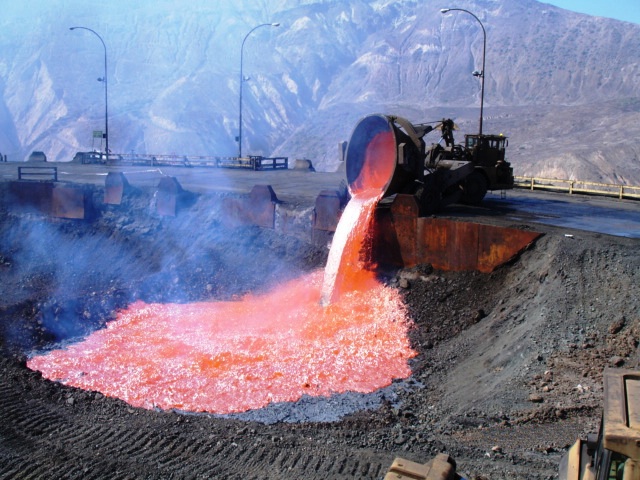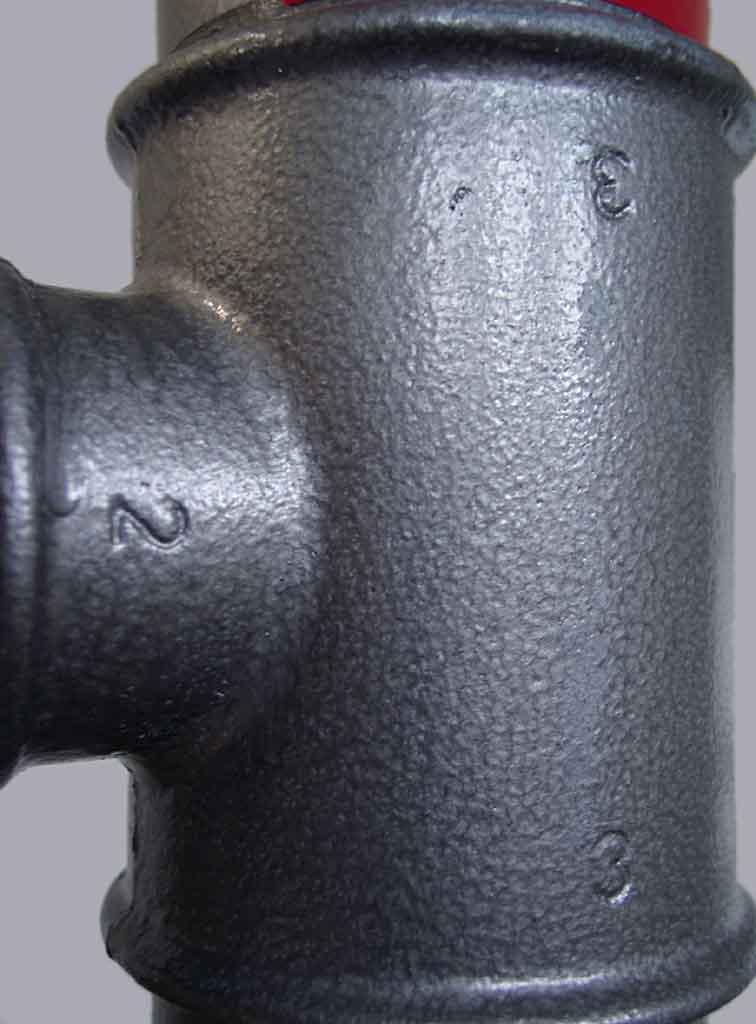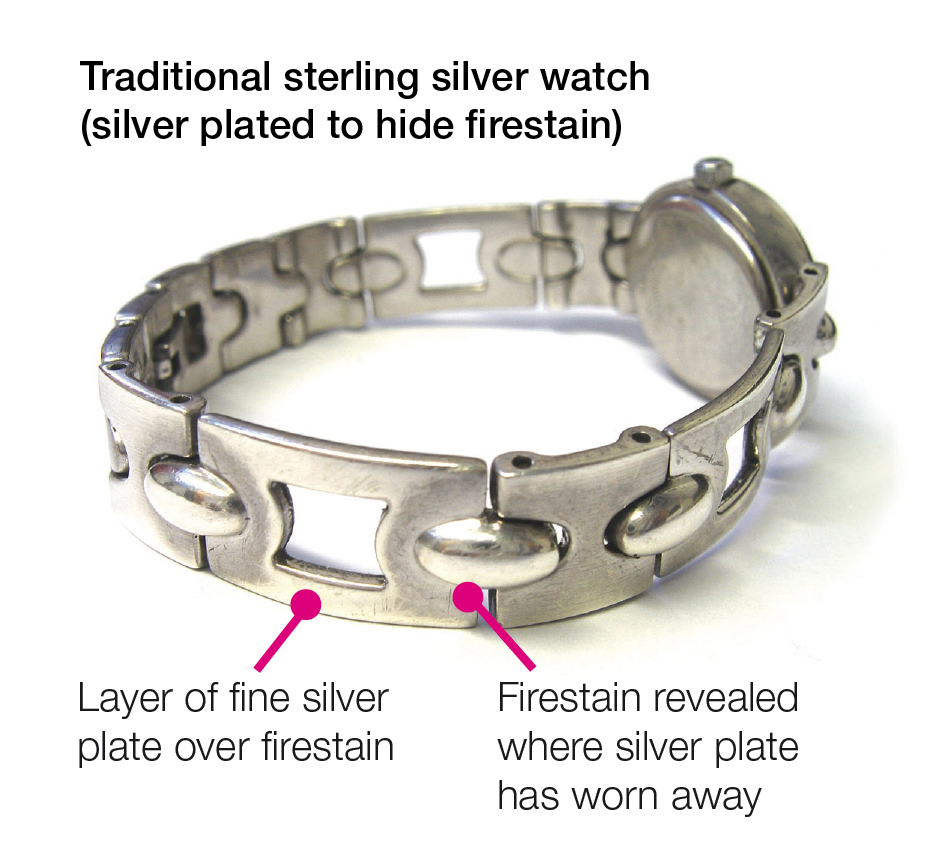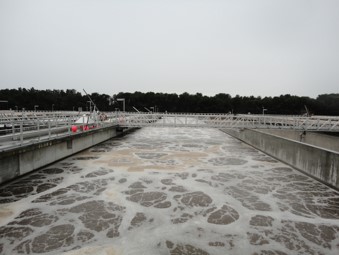|
Millscale
Mill scale, often shortened to just scale, is the flaky surface of hot rolled steel, consisting of the mixed iron oxides iron(II) oxide (, wüstite), iron(III) oxide (, hematite), and iron(II,III) oxide (, magnetite). Mill scale is formed on the outer surfaces of plates, sheets or profiles when they are produced by passing red hot iron or steel billets through rolling mills. Mill scale is bluish-black in color. It is usually less than thick, and initially adheres to the steel surface and protects it from atmospheric corrosion provided no break occurs in this coating. Because it is electrochemically cathodic to steel, any break in the mill scale coating will cause accelerated corrosion of steel exposed at the break. Mill scale is thus a boon for a while, until its coating breaks due to handling of the steel product or due to any other mechanical cause. Mill scale becomes a nuisance when the steel is to be processed. Any paint applied over it is wasted, since it will come off ... [...More Info...] [...Related Items...] OR: [Wikipedia] [Google] [Baidu] |
Welding
Welding is a fabrication (metal), fabrication process that joins materials, usually metals or thermoplastics, primarily by using high temperature to melting, melt the parts together and allow them to cool, causing Fusion welding, fusion. Common alternative methods include solvent welding (of thermoplastics) using chemicals to melt materials being bonded without heat, and #Solid-state welding, solid-state welding processes which bond without melting, such as pressure, cold welding, and diffusion bonding. Metal welding is distinct from lower temperature bonding techniques such as brazing and soldering, which do not melt the base metal (parent metal) and instead require flowing a filler metal to solidify their bonds. In addition to melting the base metal in welding, a filler material is typically added to the joint to form a pool of molten material (the weld pool) that cools to form a joint that can be stronger than the base material. Welding also requires a form of shield to ... [...More Info...] [...Related Items...] OR: [Wikipedia] [Google] [Baidu] |
Slag (welding)
Welding slag is a form of slag, or glass, vitreous material produced as a byproduct of some arc welding processes, most specifically shielded metal arc welding (also known as stick welding), submerged arc welding, and flux-cored arc welding. Slag is formed when flux (metallurgy), flux, the solid shielding material used in the welding process, melts in or on top of the weld zone (also known as Dross). Slag is the solidified remaining flux after the weld area cools.Modern Welding Technology (6th Edition), Howard B. Cary& Scott Helzer, 2004, __TOC__ Flux Welding flux is a combination of carbonate and silicate materials used in welding processes to shield the weld from atmospheric gases. When the heat of the weld zone reaches the flux, the flux melts and outgasses. The gases produced push the atmospheric gas back, preventing oxidation (and reactions with nitrogen). The melted flux covers the molten metal in the weld zone. Flux materials are chosen so that the density of the melted ... [...More Info...] [...Related Items...] OR: [Wikipedia] [Google] [Baidu] |
Slag
The general term slag may be a by-product or co-product of smelting (pyrometallurgical) ores and recycled metals depending on the type of material being produced. Slag is mainly a mixture of metal oxides and silicon dioxide. Broadly, it can be classified as ferrous (co-products of processing iron and steel), ferroalloy (a by-product of ferroalloy production) or non-ferrous/ base metals (by-products of recovering non-ferrous materials like copper, nickel, zinc and phosphorus). Within these general categories, slags can be further categorized by their precursor and processing conditions (e.g., blast furnace slags, air-cooled blast furnace slag, granulated blast furnace slag, basic oxygen furnace slag, and electric arc furnace slag). Slag generated from the EAF process can contain toxic metals, which can be hazardous to human and environmental health. Due to the large demand for ferrous, ferralloy, and non-ferrous materials, slag production has increased throughout the years des ... [...More Info...] [...Related Items...] OR: [Wikipedia] [Google] [Baidu] |
Hammer Paint
Hammer paint (or hammered paint) is a special lacquer with a surface that looks like hammered metal when dried. It is also known as hammertone. Composition The slightly iridescent areas are caused by the different orientation of very small shiny particles, which are suspended in the lacquer. These particles are often made of the mineral mica. Mica is resilient, reflective, refractive, dielectric, chemically inert, insulating, lightweight, and hydrophilic.Dolley, Thomas P. (2008"Mica"() in ''USGS 2008 Minerals Yearbook''. Alternatively, aluminium or bronze powder may be used. To make the "hammered" effect more pronounced, a small amount of silicone oil may be added directly before application. Purposes Hammer paint is often used to beautify technical apparatus or as a protective coating. The optical advantage of hammer paint is that surfaces look acceptable even if the underlying surface is not flat and smooth. To get a regular paint to look smooth, the surface would have to be p ... [...More Info...] [...Related Items...] OR: [Wikipedia] [Google] [Baidu] |
Firescale
Firestain is a layer of oxides that is visible on the surface of objects made of metal alloys containing copper when the object is heated, as by a jeweler heating a ring to apply solder during a repair. On copper-containing alloys of gold or of silver (such as sterling silver), it presents as a red or purple stain. This is because at high temperatures, oxygen mixes with the copper to form cuprous oxide and then cupric oxide, both of which disrupt the bright polished surface of the finished piece. There are various methods used to either prevent or repair firestain. Preventative methods Firestain can be largely prevented by heating the object in an atmosphere in which the oxygen has been replaced with another combustive gas such as hydrogen or ammonia. Chemical agents called fluxes can reduce firestain when applied to metals before heating. Flux is usually made out of borax but other chemical compounds also have applications as fluxes. Curative methods Techniques such as polishing ... [...More Info...] [...Related Items...] OR: [Wikipedia] [Google] [Baidu] |
Dross
Dross is a mass of solid impurities floating on a molten metal or dispersed in the metal, such as in wrought iron. It forms on the surface of low- melting-point metals such as tin, lead, zinc or aluminium or alloys by oxidation of the metal. For higher melting point metals and alloys such as steel and silver, oxidized impurities melt and float making them easy to pour off. With wrought iron, hammering and later rolling remove some dross. With tin and lead the dross can be removed by adding sodium hydroxide pellets, which dissolve the oxides and form a slag. If floating, dross can also be skimmed off. Dross, as a solid, is distinguished from slag, which is a liquid. Dross product is not entirely waste material; for example, aluminium dross can be recycled and is also used in secondary steelmaking for slag deoxidation. Etymology and usage The term ''dross'' derives from the Old English word ''dros'', meaning the scum produced when smelting metals (extracting them from their ... [...More Info...] [...Related Items...] OR: [Wikipedia] [Google] [Baidu] |
Activated Sludge
The activated sludge process is a type of biological wastewater treatment process for treating sewage or Industrial wastewater treatment, industrial wastewaters using aeration and a biological floc (biofilm), floc composed of bacteria and protozoa. It is one of several biological wastewater treatment alternatives in secondary treatment, which deals with the removal of biodegradable organic matter and suspended solids. It uses air (or oxygen) and microorganisms to Biological oxidizer, biologically oxidize organic pollutants, producing a waste sludge (or Flocculation, floc) containing the oxidized material. The activated sludge process for removing carbonaceous pollution begins with an aeration tank where air (or oxygen) is injected into the waste water. This is followed by a settling tank to allow the biological flocs (the sludge blanket) to settle, thus separating the biological sludge from the clear treated water. Part of the waste sludge is recycled to the aeration tank and the r ... [...More Info...] [...Related Items...] OR: [Wikipedia] [Google] [Baidu] |
Refractory Metals
Refractory metals are a class of metals that are extraordinarily resistant to heat and wear. The expression is mostly used in the context of materials science, metallurgy and engineering. The definitions of which elements belong to this group differ. The most common definition includes five elements: two of the fifth period (niobium and molybdenum) and three of the sixth period (tantalum, tungsten, and rhenium). They all share some properties, including a melting point above 2000 °C and high hardness at room temperature. They are chemically inert and have a relatively high density. Their high melting points make powder metallurgy the method of choice for fabricating components from these metals. Some of their applications include tools to work metals at high temperatures, wire filaments, casting molds, and chemical reaction vessels in corrosive environments. Partly due to their high melting points, refractory metals are stable against creep deformation to very high tem ... [...More Info...] [...Related Items...] OR: [Wikipedia] [Google] [Baidu] |
Substrate (printing)
Substrate is used in a converting process such as printing or coating to generally describe the base material onto which, e.g. images, will be printed. Base materials may include: * plastic films or foils, * release liner * textiles, * plastic containers * any variety of paper (lightweight, heavyweight, coated, uncoated, paperboard, cardboard, etc.), or * parchment. Electronics Printing processes such as silk-screening and photolithography are used in electronics to produce printed circuit boards and integrated circuits. Some common substrates used are;Rogers & Plett, p. 162 * Glass-reinforced epoxy, eg FR-4 board * Ceramic-PTFE laminate, eg 6010 board * Alumina ceramic * Silicon * Gallium arsenide * Sapphire * Quartz Quartz is a hard, crystalline mineral composed of silica (silicon dioxide). The Atom, atoms are linked in a continuous framework of SiO4 silicon–oxygen Tetrahedral molecular geometry, tetrahedra, with each oxygen being shared between two tet ... Referen ... [...More Info...] [...Related Items...] OR: [Wikipedia] [Google] [Baidu] |
Selenium Dioxide
Selenium dioxide is the chemical compound with the formula SeO2. This colorless solid is one of the most frequently encountered compounds of selenium. It is used in making specialized glasses as well as a reagent in organic chemistry. Properties Solid SeO2 is a one-dimensional polymer, the chain consisting of alternating selenium and oxygen atoms. Each Se atom is pyramidal and bears a terminal oxide group. The bridging Se-O bond lengths are 179 pm and the terminal Se-O distance is 162 pm.Handbook of Chalcogen Chemistry: New Perspectives in Sulfur, Selenium and Tellurium, Franceso A. Devillanova, Royal Society of Chemistry, 2007, The relative stereochemistry at Se alternates along the polymer chain ( syndiotactic). In the gas phase selenium dioxide is present as dimers and other oligomeric species, at higher temperatures it is monomeric. The monomeric form adopts a bent structure very similar to that of sulfur dioxide with a bond length of 161 pm. The dimeric form has been iso ... [...More Info...] [...Related Items...] OR: [Wikipedia] [Google] [Baidu] |
Phosphoric Acid
Phosphoric acid (orthophosphoric acid, monophosphoric acid or phosphoric(V) acid) is a colorless, odorless phosphorus-containing solid, and inorganic compound with the chemical formula . It is commonly encountered as an 85% aqueous solution, which is a colourless, odourless, and non- volatile syrupy liquid. It is a major industrial chemical, being a component of many fertilizers. The compound is an acid. Removal of all three ions gives the phosphate ion . Removal of one or two protons gives dihydrogen phosphate ion , and the hydrogen phosphate ion , respectively. Phosphoric acid forms esters, called organophosphates. The name "orthophosphoric acid" can be used to distinguish this specific acid from other " phosphoric acids", such as pyrophosphoric acid. Nevertheless, the term "phosphoric acid" often means this specific compound; and that is the current IUPAC nomenclature. Production Phosphoric acid is produced industrially by one of two routes, wet processes and dry. ... [...More Info...] [...Related Items...] OR: [Wikipedia] [Google] [Baidu] |







